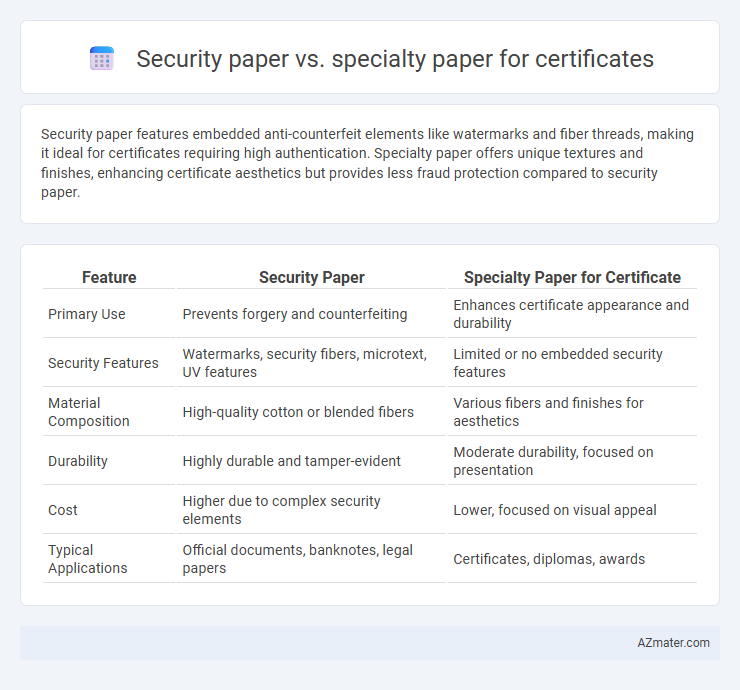Security paper features embedded anti-counterfeit elements like watermarks and fiber threads, making it ideal for certificates requiring high authentication. Specialty paper offers unique textures and finishes, enhancing certificate aesthetics but provides less fraud protection compared to security paper.
Table of Comparison
| Feature | Security Paper | Specialty Paper for Certificate |
|---|---|---|
| Primary Use | Prevents forgery and counterfeiting | Enhances certificate appearance and durability |
| Security Features | Watermarks, security fibers, microtext, UV features | Limited or no embedded security features |
| Material Composition | High-quality cotton or blended fibers | Various fibers and finishes for aesthetics |
| Durability | Highly durable and tamper-evident | Moderate durability, focused on presentation |
| Cost | Higher due to complex security elements | Lower, focused on visual appeal |
| Typical Applications | Official documents, banknotes, legal papers | Certificates, diplomas, awards |
Understanding Security Paper: Key Features
Security paper incorporates embedded features such as watermarks, microprinting, security fibers, and chemical sensitivity to prevent counterfeiting and unauthorized duplications on certificates. Specialty paper, while often customized in texture or color, lacks the advanced anti-counterfeit measures found in security paper, making it less effective for official documents requiring high authenticity. Understanding these key features is crucial for selecting the appropriate material to ensure certificate integrity and reduce fraud risks.
What Defines Specialty Paper?
Specialty paper is characterized by unique physical or chemical properties tailored for specific applications, such as enhanced durability, texture, or visual effects, often used in certificates, invitations, and artistic projects. Unlike security paper, which incorporates embedded security features like watermarks and fibers to prevent counterfeiting, specialty paper emphasizes aesthetic qualities and functional enhancements. These papers can include textured finishes, metallic accents, or customized colors, making them ideal for formal certificates requiring a distinctive, high-quality appearance.
Security Paper vs Specialty Paper: Core Differences
Security paper incorporates advanced features like watermarks, microprinting, and UV fibers to prevent counterfeiting and unauthorized duplication, essential for certificates and official documents. Specialty paper, by contrast, is customized for specific applications such as textured finishes, color variations, or enhanced durability, but lacks intrinsic anti-fraud elements. The core difference lies in security paper's embedded protective technologies designed to ensure authenticity, while specialty paper prioritizes aesthetic and functional qualities without inherent security features.
Essential Security Features in Certificate Papers
Security paper for certificates incorporates advanced features such as watermarks, microtext, and holograms to prevent counterfeiting and unauthorized duplication. Specialty paper focuses on unique textures, chemical sensitivity, and embedded fibers that enhance durability and provide tamper-evident properties. Essential security features in certificate papers ensure authenticity, safeguard against fraud, and maintain document integrity through multi-layered protection mechanisms.
Customization Options for Security and Specialty Papers
Security paper offers advanced customization options such as embedded watermarks, microprinting, UV fibers, and holograms to prevent counterfeiting and unauthorized duplication of certificates. Specialty paper allows customization through unique textures, colors, embossing, and metallic foils that enhance the aesthetic appeal and tactile differentiation of certificates. Both paper types can incorporate tailored security features and design elements, but security paper emphasizes fraud prevention while specialty paper focuses on visual and physical customization.
Cost Comparison: Security Paper vs Specialty Paper
Security paper typically incurs higher production costs due to embedded features like watermarks, security fibers, and UV-reactive elements designed to prevent counterfeiting. Specialty paper may vary in cost depending on the specific characteristics required, such as durability or texture, but generally lacks the advanced anti-fraud technology, resulting in lower pricing. Choosing security paper over specialty paper impacts overall certificate expenses by increasing unit costs, making it a critical factor in budgeting for secure document issuance.
Durability and Longevity: Which Paper Prevails?
Security paper, embedded with features like watermarks and fiber threads, offers superior durability and tamper resistance, making it ideal for certificates requiring long-term authenticity. Specialty paper, often crafted with high-quality fibers and coatings, provides excellent longevity but lacks the inherent anti-counterfeiting measures of security paper. For certificates demanding both extended lifespan and fraud protection, security paper generally prevails due to its enhanced structural integrity and built-in security features.
Choosing the Right Paper for Certificates
Security paper offers built-in features like watermarks, microprinting, and tamper-evident elements to prevent forgery and ensure authenticity, making it ideal for certificates requiring high security. Specialty paper provides unique textures, colors, and finishes that enhance visual appeal and professionalism, suitable for certificates emphasizing aesthetics. Choosing between security paper and specialty paper depends on whether the priority is preventing counterfeiting or delivering a distinguished, elegant presentation.
Common Use Cases for Each Paper Type
Security paper is commonly used for certificates requiring high authenticity and protection against forgery, such as diplomas, government-issued ID cards, and legal documents, featuring embedded watermarks, microtext, and security fibers. Specialty paper, often chosen for awards, commemorative certificates, and decorative presentations, emphasizes aesthetic qualities like textured finishes, metallic inks, or vibrant colors to enhance visual appeal rather than security features. Both paper types serve distinct roles: security paper ensures document integrity and fraud prevention, while specialty paper focuses on enhancing the certificate's look and feel for display and recognition purposes.
Industry Standards and Compliance Factors
Security paper incorporates embedded features such as watermarks, security fibers, and chemical sensitiveness that deter counterfeiting and comply with stringent industry standards like ISO 14298 for secure printing. Specialty paper, tailored for certificates, often emphasizes durability and print quality but may lack inherent security elements required to meet compliance regulations for official documents. Choosing security paper ensures adherence to compliance mandates set by regulatory bodies, reducing the risk of fraud in certificate issuance.

Infographic: Security paper vs Specialty paper for Certificate
 azmater.com
azmater.com